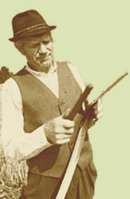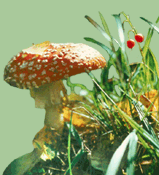Natural fur: forgotten for good?
Vello Vainura calls for revivaling the use of fur and hunting for fur-bearing animals: there is no reason why the goods of nature should be left to rot in the woods. He points out the important difference between wild fur animals and farm fur animals. It is essential to hunt wild fur animals, such as raccoon dog and fox, as their number has exceeded the critical level (mostly because of decreased mortality of rabies) and the balance between predators and small animals/birds is clearly off in Estonian forests. As long there is no demand for natural fur in world market, the hunters have no interest in hunting, or even more, in skinning the animals.
The Estonian Society for the Protection of Animals endeavors to ban the fur farms
Heiki Valner fights against fur farms, and fur products seems like needless and often cruel luxury to him. Several studies have shown the poor living conditions and the incredible cruelty related to fur farms. The appended photographs illustrate the miserable life of fur farm animals.
Animal protectors: animals are not for people
Kristina Mering and Kadri Taperson are convinced that man should not subjugate animals as commodities. The authors explain the philosophy behind those fighting for animal rights.
Nowadays fur trade: the view of a fur trader
Tarmo Kattago considers the role of fur important in current clothing as well as in future clothing. He writes about trends in world market and certification systems (Origin AssuredTM), which guarantee that farm-based fur animals are treated according to set standards. In addition, a short history and the current trends in Estonian fur industry are described and comments to Vello Vainuras article are given.
Fur and being a human
Külli Keerus adds the arguments of ethics and moral to the discussion: there are three principally different directions of ethics that bang off on the topic of fur.
The status of fish resources of the Baltic Sea is not good
Matis Mägi introduces the results of the National Audit Office focusing on the trawl catch in the Baltic Sea: fish resources are low and control over the catch should be improved. Currently, fishery counts for less than 0.5% of Estonian GDP, but it is still essential to organize fishing in a sustainable way. The resources of salmon and codfish have declined rapidly in past decades and EU has applied successful management plans for both species. EU also regulates the catch of Baltic herring and Baltic sprat. The author also writes about the bottlenecks of audit, such as the lack of cross-checking and the lack of compendious information system.
How much fish is there in the Baltic Sea?
Ain Soome looks at the amount of fish resources and discusses the cost-benefit of fishing. The resources of three most important fresh water species that live in coastal sea pike, perch and pikeperch are rather low in all sea areas surrounding Estonia. The resources of flounder the most important species of the Western waters of the West-Estonian islands have increased in the recent decade. In 2008 the Estonian fishermen caught almost 42 601 tons of Baltic sprat, 32 000 tons of Baltic herring, 972 tons of codfish and 5.6 tons of salmon from the Baltic Sea.
Supervision of fish resources
Indrek Ulla considers the aptness of the Environmental Inspectorate as appropriate for protecting fish resources. He says that the bottlenecks pointed out in the last audit have been removed, and due to cooperation between different institutions, the control over fishing should now meet the needed standards, by checking the whole chain from catch to sale.
Fishing is not Estonian Nokia!
Markus Vetemaa, a fish scientist, claims that the upper limit of fishing is almost exceeded: it is not possible to catch much more fish than now. Due to improved fishing techniques, more and more fishermen are left out of job. In the current economic crisis this certainly has a negative effect on illegal fishing.
The role of salmon species in Estonian fishing
Tiit Paaver points out that salmon species caught from the natural waterbodies can only be meaningful for hobby fishers: It is much more profitable to raise salmons in artificial fisheries. Most salmons in Estonian waters, as well as in the waters of other European seaside countries, have been raised in fisheries. Given the circumstances when thousands of tons of salmons are imported to Estonia yearly, the salmon catch from our coastal waters remains minimal, but yet necessary for the natural balance of our waters.
Practical tips: our Limacella mushrooms
Mall Vaasma describes the close relatives of Boletus species, with the help of Vello Liivs photos.
Interview: Nature is not that far from us
Toomas Kukk has interviewed Rein Kuresoo, an expert of and writer about nature.
Does the area of the Piirisaar Island really decrease?
Brit Peensoo, Tiit Hang and Raivo Aunap try to disprove the myth about the sinking island. In 1926 geographer August Mieler claimed, based on the comparison of three maps from different periods that the area of Piirisaar had decreased by 62% during the past 200 years. The authors have tried to find explanations for such a quick decrease and to find out if Mielers measurements were correct at all. We do not know much about the development of the island, and comparison of maps is really only an alternative way to get an idea of the changes in the islands coastline. Based on current work, the authors argue that the area of Piirisaar has not decreased significantly, but the coastline has certainly changed.
Estonian Nature enquires
Erki Tammiksaar writes about the celebrating 180 years since conquering Mount Ararat.
Urmas Tartes introduces shortly the contest Wildlife Photographer of the Year
Tree of the Year: Hazelnut in folk tales
Mall Hiiemäe takes a glance at the folklore related to hazelnut trees: more importance has been ascribed to this tree than to most other trees. Hazelnuts are ancient symbols of fertility and are therefore related to folklore comprising marriage and children. The author brings on many examples of folktales and beliefs about picking and using hazelnuts.
Peeking into the cradle of oil shale industry
Mait Sepp recalls the first years of oil shale research and industry in Estonia. The first written records about oil shale date back from 1777 by August William Hupel, but most probably oil shale was known already in the beginning of the 18th century. A.-J. Engelhardt was the first one to describe and test oil shale; J. G. Georgi the first one to publish a scientific article about oil shale and the related experiments (in 1789). First true scientific researches involving oil shale were published by G. von Helmersen (in 1838 and 1839). In 1919 or 1920 the first oil shale quarries were opened for commercial mining.
|


![[IN ENGLISH]](images/gb.gif)





